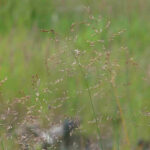Fowl Bluegrass
Poa palustris L.
General Description
Fowl bluegrass is a loosely tufted, low growing, native, cool season, perennial bunchgrass. It is commonly a minor component in native grass seed mixes. It has fibrous roots and a tufted bunchgrass growth habit, but can form a weak sod.
Type
Native grass.
Origin
Native to British Columbia.
Longevity
Moderate, 5-10 years.
Use
Reclamation. Used as a minor component in native grass reclamation mixes and is considered an early- to mid-successional species. It has forage value and is used in pastures by both wildlife and livestock, where moisture is sufficient. The Chipewyan used fowl bluegrass to make vaccines or allergens to treat hay fever and to make hair rinses to revitalize hair.
Optimal Time of Use
Early in the spring.
Recovery After Use
Slow recovery after clipping or grazing. This species can be either an increaser or a decreaser after grazing, depending on site conditions.
Palatability/Nutritional Value
Fowl bluegrass is noted to have low protein and low palatability for both browsing and grazing animals.
Annual Precipitation min/max (mm)
450mm / 570mm.
Drought Tolerance
Low drought tolerance.
Flooding Tolerance
Although fowl bluegrass has a low tolerance to flooding, it is sometimes considered a wetland species indicator.
Winter Hardiness
Fowl bluegrass can tolerate temperatures as low as -38°C.
Soil Texture Preference
Adapted to medium-textured or loam soils to fine-textured or clayey soils.
Erosion Control
Has moderate value for use in erosion control.
Salinity Tolerance
Low tolerance.
Acidity Tolerance
High tolerance, found on soils with pH as low as 4.9.
Alkalinity Tolerance
Low tolerance, found on soils up to pH 7.5.
Seeds per kg
6,957,000 seeds/kg (3,155,656 seeds/lb).
Suggested Mixtures
Suitable for use with other native species.
Ease of Establishment
Fowl bluegrass has moderate seedling vigour. Seeds per gram should be verified when calculating seeding rate, as the seed weights reported in literature varied from 4.187 to 6.957 million seeds per kilogram.
Competitiveness
Moderately competitive where it is adapted.
Management Considerations
Several species of native bluegrasses including fowl bluegrass can cause problems for pedigreed seed growers as these species are difficult to clean out of other grass seed crops.
BC Rangeland Seeding Manual, USDA Plants Database
Fowl bluegrass is found in all zones in the Central Interior region, but in the southern part of the the region it is best adapted to moist transitional areas in the Interior Douglas-fir zone.
Fowl bluegrass is found in all zones in the region, but is best adapted to moist transitional areas in the Interior Douglas-fir and Interior Cedar-Hemlock zones.
Fowl bluegrass is common in native plant communities of the Peace-Liard region. It can be highly competitive and persistent. This has caused problems for local seedgrowers who need to keep fields clean for other forage seed crops.
